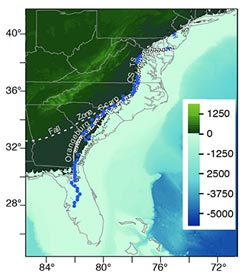LLNL scientist finds topography of Eastern Seaboard muddles ancient sea level changes

The reconstructed shoreline of the eastern U.S. at 3 million years ago (colors represent topography in meters). The reconstruction is based on mantle flow and glacial isostatic adjustment over the past 3 million years. The predicted shoreline is in good agreement with geologic inferences which has implications on understanding the past long-term sea level change.<br>
Sedimentary rocks from Virginia through Florida show marine flooding during the mid-Pliocene Epoch, which correlates to approximately 4 million years ago. Several wave-cut scarps (rock exposures), which originally would have been horizontal, are now draped over a warped surface with up to 60 meters variation.
Nathan Simmons of Lawrence Livermore National Laboratory and colleagues from the University of Chicago, Universite du Quebec a Montreal, Syracuse University, Harvard University and the University of Texas at Austin modeled the active topography using mantle convection simulations that predict the amplitude and broad spatial distribution of this distortion. The results imply that dynamic topography and, to a lesser extent, glacial adjustment, account for the current architecture of the coastal plain and nearby shelf.
The results appear in the May 16 edition of Science Express, and will appear at a later date in Science Magazine.
“Our simulations of dynamic topography of the Eastern Seaboard have implications for inferences of global long-term sea-level change,” Simmons said.
The eastern coast of the United States is considered an archetypal Atlantic-type or passive-type continental margin.
“The highlight is that mantle flow is a major component in distorting the Earth's surface over geologic time, even in so-called 'passive' continental margins,” Simmons said. “Reconstructing long-term global sea-level change based on stratigraphic relations must account for this effect. In other words, did the water level change or did the ground move? This could have implications on understanding very long-term climate change.”
The mantle is not a passive player in determining long-term sea level changes. Mantle flow influences surface topography, through perturbations of the dynamic topography, in a manner that varies both spatially and temporally. As a result, it is difficult to invert for the global long-term sea level signal and, in turn, the size of the Antarctic Ice Sheet, using east coast shoreline data.
Simmons said the new results provide another powerful piece of evidence that mantle flow is intimately involved in shaping the Earth's surface and must be considered when attempting to unravel numerous long-term Earth processes such as sea-level variations over millions of years.
Founded in 1952, Lawrence Livermore National Laboratory provides solutions to our nation's most important national security challenges through innovative science, engineering and technology. Lawrence Livermore National Laboratory is managed by Lawrence Livermore National Security, LLC for the U.S. Department of Energy's National Nuclear Security Administration.
Media Contact
All latest news from the category: Earth Sciences
Earth Sciences (also referred to as Geosciences), which deals with basic issues surrounding our planet, plays a vital role in the area of energy and raw materials supply.
Earth Sciences comprises subjects such as geology, geography, geological informatics, paleontology, mineralogy, petrography, crystallography, geophysics, geodesy, glaciology, cartography, photogrammetry, meteorology and seismology, early-warning systems, earthquake research and polar research.
Newest articles

Properties of new materials for microchips
… can now be measured well. Reseachers of Delft University of Technology demonstrated measuring performance properties of ultrathin silicon membranes. Making ever smaller and more powerful chips requires new ultrathin…

Floating solar’s potential
… to support sustainable development by addressing climate, water, and energy goals holistically. A new study published this week in Nature Energy raises the potential for floating solar photovoltaics (FPV)…

Skyrmions move at record speeds
… a step towards the computing of the future. An international research team led by scientists from the CNRS1 has discovered that the magnetic nanobubbles2 known as skyrmions can be…




















